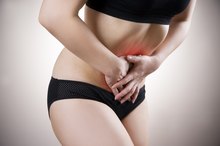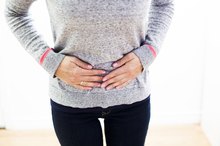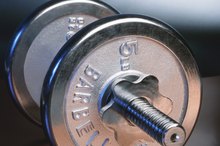Causes of Lower Abdominal & Testicular Pain
Shared nerves carry pain sensations from the lower abdomen and scrotum, which contains the testicles and other male reproductive structures. For this reason, pain originating in either location is often felt in both areas.
If you are experiencing serious medical symptoms, seek emergency treatment immediately.
**Similarly, the causes of lower abdominal and testicular or scrotal pain can be due to abnormalities affecting structures in either location.
** Many conditions can lead to lower abdominal and scrotal pain, some of which can lead to permanent testicular damage if not treated quickly. It's important to see your doctor for an accurate diagnosis and appropriate treatment if you experience lower abdominal and testicular pain.
Testicular Trauma
As any man can attest, a blow to the scrotum typically causes intense testicular pain.
With severe trauma, the pain often extends into the lower abdomen and may be accompanied by nausea, vomiting and possibly difficulty urinating.
A high-force blow to the scrotum can damage the testicles or cause bleeding within the scrotum.
Medical evaluation is needed if there is scrotal swelling, tenderness or bruising. Cold packs and over-the-counter pain relievers generally suffice for minor scrotal trauma.
- As any man can attest, a blow to the scrotum typically causes intense testicular pain.
- A high-force blow to the scrotum can damage the testicles or cause bleeding within the scrotum.
Groin Hernia
Lower Stomach & Groin Pain
Learn More
A groin hernia describes protrusion of abdominal contents through a weak area in the groin region of the abdominal wall. Most are inguinal hernias, which form at the site where the spermatic cord passes from the abdomen into the scrotum in men. Most groin hernias develop gradually and initially cause no pain.
They often cause a lump in the groin, which may extend into the scrotum.
A sudden or large groin hernia can cause aching pain in the lower abdomen and scrotum. The pain often comes and goes, and is typically relieved by lying down. Constant, worsening pain may indicate a groin hernia complication and requires immediate medical evaluation and treatment.
- A groin hernia describes protrusion of abdominal contents through a weak area in the groin region of the abdominal wall.
- They often cause a lump in the groin, which may extend into the scrotum.
Testicular Torsion
Testicular torsion describes twisting of the spermatic cord within the scrotum. Among other structures, this cord carries the artery that supplies blood to the testicle and other scrotal structures.
Twisting of the cord disrupts this blood supply leading to sudden, severe, one-sided testicular pain and swelling. Lower abdominal pain, nausea and vomiting also frequently occur with testicular torsion. Teens going through puberty and men younger than 25 are at the greatest risk for testicular torsion, though the condition can occur in older males.
Testicular torsion requires emergency surgical treatment to avoid loss of the affected testicle. Death of the testicle can occur within 4 to 8 hours.
- Testicular torsion describes twisting of the spermatic cord within the scrotum.
Epididymitis and Orchitis
What Are the Causes of Swollen Testicles?
Learn More
Epididymitis refers to inflammation of the epididymis, a structure on the back of the testicle that transports sperm. A bacterial infection most commonly causes epididymitis, such as the sexually transmitted diseases chlamydia and gonorrhea 4. The testicle can also become infected in some cases, a condition known as orchitis.
One-sided scrotal pain typically develops gradually with infectious epididymitis, with or without orchitis. This characteristic helps distinguish these conditions from testicular torsion. The pain progresses over days to weeks, along with scrotal tenderness and swelling, burning with urination, increased urinary frequency, painful ejaculation and possibly a low fever. Lower abdominal pain also develops in some men. Noninfectious epididymitis and ochitis can develop due to an enlarged prostate, back flow of urine into the epididymis, or as a side effect of certain prescription medications.
- Epididymitis refers to inflammation of the epididymis, a structure on the back of the testicle that transports sperm.
- The testicle can also become infected in some cases, a condition known as orchitis.
Other Causes
**A number of other medical conditions can cause lower abdominal and scrotal pain.
** Most of these conditions involve abdominal structures with referred pain to the scrotum. For example, a stone or other obstruction of the ureter -- the tube that carries urine from the kidney to the bladder -- can lead to these symptoms.
Lower abdominal or pelvic tumors and scar tissue formation in the space behind the abdominal cavity can also sometimes cause lower abdominal and scrotal pain. Appendicitis or a herniated disc in the low spine might be the culprit, although other symptoms usually make these conditions relatively obvious.
- A number of other medical conditions can cause lower abdominal and scrotal pain.
- For example, a stone or other obstruction of the ureter -- the tube that carries urine from the kidney to the bladder -- can lead to these symptoms.
When To Seek Medical Care
Although it can be embarrassing to discuss scrotal or testicular pain, it's important to seek medical attention if you experience this symptom -- with or without abdominal pain. Medical evaluation is especially important if your pain develops suddenly, is worsening, or is accompanied by other symptoms.
Reviewed by: Tina M. St. John, M.D.
- Although it can be embarrassing to discuss scrotal or testicular pain, it's important to seek medical attention if you experience this symptom -- with or without abdominal pain.
- Medical evaluation is especially important if your pain develops suddenly, is worsening, or is accompanied by other symptoms.
Related Articles
References
- American Journal of Roentgenology: Differentiation of Femoral Versus Inguinal Hernia: CT Findings
- American Family Physician: Testicular Torsion: Diagnosis, Evaluation, and Management
- American Urological Association: Acute Scrotum
- American Family Physician: Epididymitis and Orchitis: An Overview
- Andrology for the Clinician; Wolf-Bernhard Schill, et al.
- Genitourinary Pain and Inflammation: Diagnosis and Management; Jeannette M. Potts
- Urology Times: How to Manage Testicular/Groin Pain: Medical and Surgical Ladder
- Gordhan CG, Sadeghi-Nejad H. Scrotal pain: evaluation and management. Korean J Urol. 2015;56(1):3–11. doi:10.4111/kju.2015.56.1.3
- Tan WP, Levine LA. What Can We Do for Chronic Scrotal Content Pain?. World J Mens Health. 2017;35(3):146–155. doi:10.5534/wjmh.17047
- Levine L. Chronic orchialgia: evaluation and discussion of treatment options. Ther Adv Urol. 2010;2(5-06):209–214. doi:10.1177/1756287210390409
- Michel V, Pilatz A, Hedger MP, Meinhardt A. Epididymitis: revelations at the convergence of clinical and basic sciences. Asian J Androl. 2015;17(5):756–763. doi:10.4103/1008-682X.155770
- Okonkwo KC, Wong KG, Cho CT, Gilmer L. Testicular trauma resulting in shock and systemic inflammatory response syndrome: a case report. Cases J. 2008;1(1):4. Published 2008 May 12. doi:10.1186/1757-1626-1-4
- HerniaSurge Group. International guidelines for groin hernia management. Hernia. 2018;22(1):1–165. doi:10.1007/s10029-017-1668-x
- Tan WP, Levine LA. An overview of the management of post-vasectomy pain syndrome. Asian J Androl. 2016;18(3):332–337. doi:10.4103/1008-682X.175090
- Breen M, Murphy K, Chow J, Kiely E, O'Regan K. Acute idiopathic scrotal edema. Case Rep Urol. 2013;2013:829345. doi:10.1155/2013/829345
- Sharp VJ, Kieran K, Arlen AM. Testicular torsion: diagnosis, evaluation, and management. Am Fam Physician. 2013;88(12):835-40. PMID: 24364548
- Khan O, Protheroe A. Testis cancer. Postgrad Med J. 2007;83(984):624–632. doi:10.1136/pgmj.2007.057992
- Chennamsetty A, Khourdaji I, Burks F, Killinger KA. Contemporary diagnosis and management of Fournier's gangrene. Ther Adv Urol. 2015;7(4):203–215. doi:10.1177/1756287215584740
- Tenório CEL, Lima SVC, Albuquerque AV, Cavalcanti MP, Teles F. Risk factors for mortality in fournier's gangrene in a general hospital: use of simplified founier gangrene severe index score (SFGSI). Int Braz J Urol. 2018;44(1):95–101. doi:10.1590/S1677-5538.IBJU.2017.0193
- Kim SD, Kim SW, Yoon BI, et al. The Relationship between Clinical Symptoms and Urine Culture in Adult Patients with Acute Epididymitis. World J Mens Health. 2013;31(1):53–57. doi:10.5534/wjmh.2013.31.1.53
- Javadpour N, Mcintire KR, Waldmann TA. Human chorionic gonadotropin (HCG) and alpha-fetoprotein (AFP) in sera and tumor cells of patients with testicular seminoma: a prospective study. Cancer. 1978;42(6):2768-72. doi:10.1002/1097-0142(197812)42:6<2768::aid-cncr2820420636>3.0.co;2-z
- Agrawal AM, Tripathi PS, Shankhwar A, Naveen C. Role of ultrasound with color Doppler in acute scrotum management. J Family Med Prim Care. 2014;3(4):409–412. doi:10.4103/2249-4863.148130
- Patel AP. Anatomy and physiology of chronic scrotal pain. Transl Androl Urol. 2017;6(Suppl 1):S51–S56. doi:10.21037/tau.2017.05.32
- Rupp TJ. Epididymitis. StatPearls [Internet]. Published May 2, 2019.
- Gordon J, Rifenburg RP. Spermatic Cord Anesthesia Block: An Old Technique Re-imaged. West J Emerg Med. 2016;17(6):811–813. doi:10.5811/westjem.2016.8.31017
- Oliveira RG, Camara C, Alves Jde M, Coelho RF, Lucon AM, Srougi M. Microsurgical testicular denervation for the treatment of chronic testicular pain initial results. Clinics (Sao Paulo). 2009;64(5):393–396. doi:10.1590/s1807-59322009000500004
- Testicular Cancer Diagnosis: Testicular Cancer Testing. American Cancer Society. Published May 17, 2017.
Writer Bio
Sylvie Tremblay holds a Master of Science in molecular and cellular biology and has years of experience as a cancer researcher and neuroscientist. Based in Ontario, Canada, Tremblay is an experienced journalist and blogger specializing in nutrition, fitness, lifestyle, health and biotechnology, as well as real estate, agriculture and clean tech.







